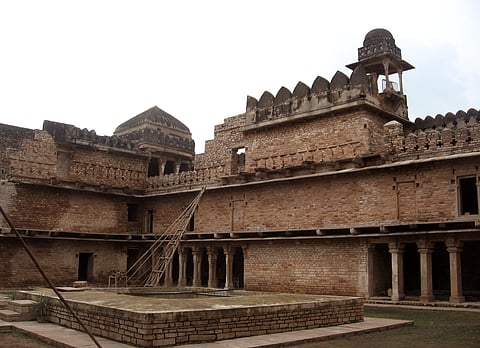
- Destinations
- Experiences
- Stay
- What's new
- Editor’s Picks
- Responsible Tourism
- CampaignsCampaigns
- Subscribe

Chanderi Fort, nestled in the heart of Madhya Pradesh, stands as a testament to the region's rich history, architectural opulence, and cultural significance. Sitting atop a hill, the fort overlooks the quaint town of Chanderi as it grows out of its foot and spreads in a great expanse. The place is known for its ancient Jain temples and exquisite Chanderi sarees. This fortress, with its sprawling layout and strategic position, has witnessed numerous historical events and has been a pivotal site in the region's history. Let us delve into the details of the fort to unpack everything a traveller needs to know before visiting.
The history of Chanderi Fort is as layered and complex as the fort itself. The fort’s origins can be traced back to the early 11th century, though it gained prominence during the rule of the Malwa Sultans in the 15th and 16th centuries. The strategic location of Chanderi, lying on the trade route between Central India and the Deccan, made it a coveted possession for various empires. It played a crucial role in the military and trade endeavours of the Delhi Sultanate and later the Mughals.
Throughout its history, Chanderi Fort has been the focal point of numerous battles and sieges. One of the most notable events was the siege by Babur in 1528, which was part of his campaign to consolidate power in Northern India. Babur's capture of Chanderi marked a significant moment in his military conquests. The fort also witnessed conflicts during the reign of the Scindias, and it continued to be a site of strategic importance through the Maratha period and the British colonial era.
Today, Chanderi Fort is part of a historic fort town with many temples, mosques, gardens, and palaces. The fort's main gate is known as the "Khooni Darwaza."
The architecture of Chanderi Fort commingles various styles, reflecting the diverse influences of its rulers. The fort’s design incorporates elements of Rajput, Malwa, and Mughal architecture, creating a unique amalgamation that is both aesthetically pleasing and strategically sound. The fort is characterised by its massive stone walls, intricate carvings, and grand gateways.
One of the most striking features of the fort is the Kirti Durg, an entrance gate. This imposing gateway, adorned with intricate carvings and designs, stands as a testament to the fort’s architectural prowess. Another notable structure is the Hawa Paur, also known as the 'Gate of Winds,' which served as a vantage point and a cooling mechanism for the fort's inhabitants. The inner structures of the fort, including the palaces, halls, and temples, showcase detailed stonework and ornate designs that speak volumes about the artisans’ skills.
Among the numerous temples, the Jain temples are particularly significant. These temples, adorned with detailed carvings of Jain Tirthankaras, reflect the deep-rooted religious history of the region. The rock-cut Jain temple of Choubisi is especially noteworthy for its 24 statues of the Jain deities.
Koshak Mahal
Koshak Mahal is an architectural marvel built in 1445 by Sultan Mahmud Shah Khilji of Malwa. This four-storied structure was originally intended to have seven stories, and its unique, symmetrical design showcases a blend of Islamic and Hindu architectural elements, making it a must-visit for history and architecture enthusiasts.
Badal Mahal Gate
Badal Mahal Gate, an iconic entrance built in the 15th century, serves as a gateway to the historical town of Chanderi. This towering structure, adorned with intricate carvings and motifs, exemplifies the grandeur of medieval architecture and offers a glimpse into the region’s rich cultural heritage.
Jama Masjid
The Jama Masjid in Chanderi, constructed in 1251, is renowned for its impressive central dome and three imposing gates. This mosque, an exquisite example of Afghan architecture, stands out for its expansive courtyard and beautifully carved minarets, offering a peaceful atmosphere for visitors.
Shehzadi Ka Rauza
Shehzadi Ka Rauza is a mausoleum believed to be dedicated to a young princess, featuring a blend of Islamic and Hindu architectural styles. This serene site, surrounded by lush gardens, is known for its intricate carvings and serene ambience, providing a reflective space for visitors.
Chanderi Museum
The Chanderi Museum houses a remarkable collection of artefacts, sculptures, and textiles highlighting the town's rich history and cultural heritage. Visitors can explore exhibits that include ancient coins, terracotta figurines, and traditional Chanderi sarees, offering a comprehensive overview of the region's past.
Battisi Baoli
Battisi Baoli, a magnificent stepwell built in the 15th century, features 32 steps leading down to the water. This architectural wonder served as a crucial water source and a resting place for travellers, showcasing the ingenuity and artistry of ancient water management systems.
Handloom Park
Handloom Park in Chanderi offers an insightful glimpse into the traditional weaving techniques used to create the famous Chanderi sarees. Visitors can witness skilled artisans at work and purchase exquisite handwoven fabrics, supporting local crafts and preserving this age-old tradition.
Timings: 6 am to 6 pm
Entry Fees: Admission to the place is free.
Air: The nearest airport to Chanderi is the Gwalior Airport (GWL) which is 176 km away.
Rail: Lalitpur which has its railhead, is only 40 km from Chanderi.
Road: Located 50 km from district headquarter of Ashoknagar, Chanderi is well accessible by roads.
